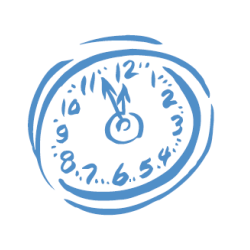Source Institutions
Source Institutions
Add to list Go to activity
Activity link broken? See if it's at the internet archive

In this activity about daily rhythms (on page 17 of the PDF), learners will explore circadian patterns in humans, animals and plants. They will observe that some behaviors and functions of living organisms vary predictably every 24 hours and many regular functions are governed by internal "clocks," which run independently but are cued or reset by the environment. Groups of learners can conduct one of four (or more) body clock investigations: body temperature, animal behavior, bean leaf, and alertness/heart rate. Materials required for each group will vary, depending on the investigation(s) being conducted. This lesson guide includes background information, setup and management tips, extensions and a handout.
- Under 5 minutes
- 1 to 7 days
- $1 - $5 per group of students
- Ages 8 - 14
- Activity, Experiment/Lab Activity, Lesson/Lesson Plan
- English
Quick Guide
Materials List (per group of students)
- Digital thermometer with several sterile covers (and access to a fever thermometer at home)
- Copy of student sheet (p. 20)
- Source of natural sunlight, or fluorescent "grow light" with timer
- 4 bean plants (purchase or grow in small pots from seed)
- Study animals that can be observed in the classroom throughout the day (gerbils, birds, crickets, etc.)
- Science journals or graph paper
- Stopwatch or timer (if necessary)
- Other materials as needed
Subjects
-
Earth and Space Science
-
Earth, Moon and Sun
- Days
-
Earth, Moon and Sun
-
Life Sciences
-
Diversity of Life
- Plants
- Animals
- Ecology
-
Heredity and Genetics
- Human Genetics
-
Human Body
- The Brain and Nervous System
- Circulation
- Health and Nutrition
-
Diversity of Life
-
Mathematics
-
Algebra
- Patterns
-
Data Analysis and Probability
- Data Analysis
- Data Collection
- Data Representation
-
Measurement
- Rate
- Reasoning and Proof
- Representation
-
Algebra
-
The Nature of Technology
-
The Design Process
- Problem Solving
-
The Design Process
-
Physical Sciences
-
Heat and Thermodynamics
- Heat and Temperature
-
Heat and Thermodynamics
-
The Nature of Science
-
The Scientific Process
- Conducting Investigations
- Gathering Data
- Formulating Explanations
- Communicating Results
-
The Scientific Process
Informal Categories
- Animals
- Gardening
- Nature and Environment
Audience
To use this activity, learners need to:
- see
- read
- touch
Learning styles supported:
- Involves teamwork and communication skills
- Involves hands-on or lab activities
Other
Includes alignment to state and/or national standards:
This resource is part of:
Access Rights:
- Free access
By:
- Moreno, Nancy P. ; Tharp, Barbara Z. ; Vogt, Greg L.
Rights:
- All rights reserved, Baylor College of Medicine, 2009
Funding Source:
- NASA, NCC 9-58
